文章信息
- 胡梦娇, 崔元璐
- HU Mengjiao, CUI Yuanlu
- 甘草酸的文献计量学分析与可视化
- A bibliometric analysis and visualization of glycyrrhizic acid
- 天津中医药, 2022, 39(7): 873-878
- Tianjin Journal of Traditional Chinese Medicine, 2022, 39(7): 873-878
- http://dx.doi.org/10.11656/j.issn.1672-1519.2022.07.12
-
文章历史
- 收稿日期: 2022-04-10
CiteSpace是一个免费的,用于数据可视化和文献计量分析的Java应用程序[1]。用于文献计量分析,并通过知识图谱回溯一段时间内某领域的发展情况,以加深对于数据库内文献价值的探索和挖掘,可以找出各方向的多发文作者和期刊、高被引论文、高被引作者等撰写文章和投稿方面的重要信息,为新的研究指明合适的方向与角度[2-3]。CiteSpace的主要输入数据来源是Web of Science数据库,它收录了全球自然科学、生物医学、社会人文等领域的13 000多家权威期刊[4]。通过对数据库的简单检索,学者可以有效获得文献的引文情况、作者资料、摘要内容等信息,对信息进行简单的聚类和分析,了解各领域的历史和最新进展。
甘草酸是中药甘草中的主要活性成分,具有抗炎、抗病毒、调节免疫系统、保肝、抗肿瘤等作用[5-6]。学术界对甘草酸的研究主要围绕免疫系统相关疾病,由于在肝脏细胞上具有结合位点,其保肝作用和肝靶向能力也被广为关注[7-9]。随着2020年新型冠状病毒肺炎(COVID-19)的盛行,由于可与新型冠状病毒的细胞表面受体ACE2结合,甘草酸被大量学者作为COVID-19的潜在治疗药物而研究[10-12]。文章针对2000—2020年Web of Science数据库中收录的文献进行计量分析,意图找寻该方向的研究趋势和热点问题,为甘草酸的进一步研究提供背景依据。
1 方法 1.1 文献的检索和数据的下载在Web of Science数据库中设置文献类型为研究性论文和综述,分别以Glycyrrhizic Acid、Glycyrrhizin Acid、Glycyrrhiza Acid、Glycyrrhizinate和glycyrrhizic为主题,检索2000—2020年期间以甘草酸为主题的,语言为英文的文献。将检索结果合并、去重,导出为全记录与引用的参考文献,格式为纯文本,文件名为“ Download_甘草酸”。
1.2 研究方法按照程序要求建立文件夹和文件,将文献信息导入CiteSpace中,设置数据的导入导出路径及新项目名称。设置时间区间为2000—2020年,每年为1个时间切片。主题词来源和筛选标准均采取默认条件,视图谱复杂情况选择方法修剪路径以保持图谱的可看性。依次选取关键词、类别、作者、机构、国家共被引文献、共被引作者和共被引期刊为节点类型分析文献数据。
2 结果按照以上研究方法在Web of Science数据库中共检索到2 418篇文献,其中2 246篇(93.63%)为研究性论文,154篇(6.36%)为综述。文献总被引次数为48 068次,共引用30 486篇文献。
2.1 文章发表数量分析自2000—2020年,以甘草酸为主题的发文量由43篇增加到了244篇,实现了5倍以上的增长。其中以2012、2014年和2019年增量最多,均达到了30篇及以上的年增长量。见图 1。
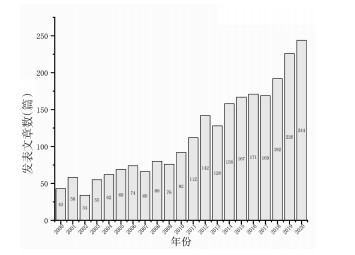
|
| 图 1 文献发表数量年度趋势统计图 Fig. 1 Annual trend chart in number of articles published |
使用CiteSpace程序对文献数据中的共现关键词进行计量分析,得到包含427个节点和1 829条连线的图谱,其中出现频次最高的10个关键词分别为Glycyrrhizic Acid(1 174次)、Licorice(438次)、Acid(367次)、In Vitro(216次)、Expression(197次)、Cell(186次)、Apoptosis(174次)、Flavonoid(147次)、Glycyrrhiza Glabra(146次)和Inhibition(146次)。见图 2。出现频次多于20次的关键词中有75个,关键词的最强引文爆发情况见图 3。
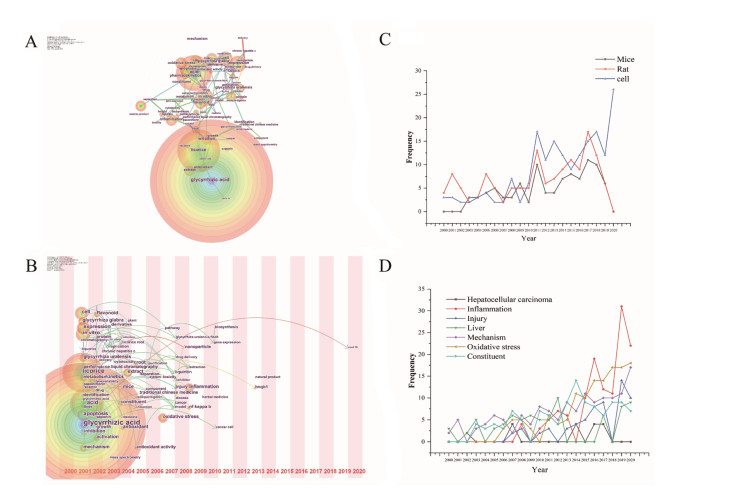
|
| 注:A.共现关键词文献计量图谱及分析,关键词出现的频率表现为节点的直径大小。B关键词初现时间图谐,节点下方的时间是关键词初次出现的时间,节点的大小代表关键词出现的次数,节点间的连线代表关键词之间的联系。 图 2 共现关键词图谱分析 Fig. 2 Analysis of co-occurrence keyword |
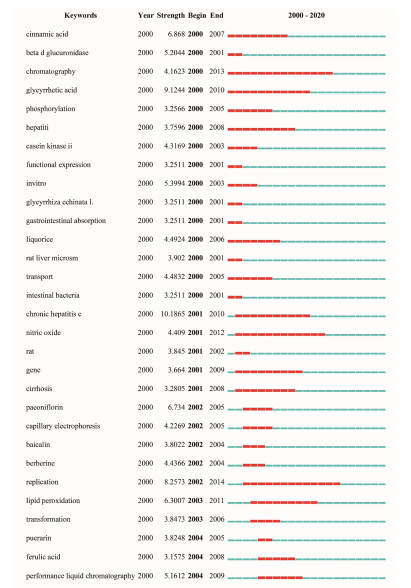
|
| 图 3 前30个关键词高被引爆发情况 Fig. 3 Top 30 keywords with the strongest citation bursts |
对文献数据中的发文作者进行计量分析,得到包含778个节点和1 653条连线的图谱,得出近20年在甘草酸相关领域发文最多的10位作者分别为7位中国学者(206篇)和3位俄罗斯学者(70篇);对文献数据中的发文国家进行计量分析,得到包含38个节点和111条连线的图谱,发文最多的10个国家分别为中国(1 133篇)、日本(281篇)、韩国(186篇)、美国(180篇)、印度(152篇)、俄罗斯(115篇)、意大利(85篇)、伊朗(78篇)、德国(68篇)、埃及(34篇)。见图 4。
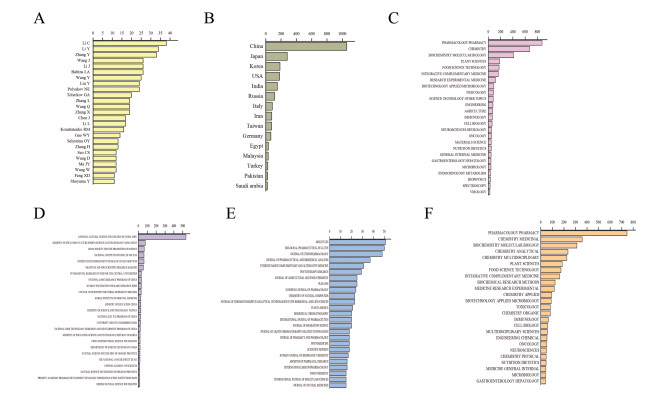
|
| 注: A.作者, B.国家, C.研究方向, D.资金援助机构, E.期刊, F.WOS分类。 图 4 文献分析结果 Fig. 4 Results of articles analysis |
使用CiteSpace程序分析文献的研究领域,得到包含80个节点和251条连线的图谱。其中发文量占前10的领域分别是Pharmacology Pharmacy(876篇)、Chemistry(676篇)、Biochemistry Molecular Biology(414篇)、Plant Sciences(186篇)、Food Science Technology(174篇)、Integrative Complementary Medicine(164篇)、Research Experimental Medicine(117篇)、Biotechnology Applied Microbiology(91篇)、Toxicology(84篇)和Science Technology Other Topics(82篇)。研究的资金来源主要有National Natural Science Foundation of China(537篇)、Ministry of Education Culture Sports Science And Technology Japan(79篇)、Japan Society for The Promotion of Science(66篇)、National Institutes of Health(64篇)、United States Department of Health Human Services(64篇)、National Institutes of Health(64篇)、United States Departmentof Health Human Services(64篇)、Grants In Aid for Scientific Research Kakenhi(57篇)、Fundamental Research Funds for The Central Universities(36篇)、National Basic Research Programof China(35篇)、Russian Foundation for Basic Research(35篇)和Council of Scientific and Industrial Research(32篇);发表文献数量前10的期刊有Molecules(51篇)、Biological Pharmaceutical Bulletin(50篇)、Journal of Ethnopharmacology(48篇)、Journal of Pharmaceutical and Biomedical Analysis(37篇)、Evidence Based Complementary and Alternative Medicine(31篇)、Phytotherapy Research(29篇)、Journal of Agricultural and Food Chemistry(25篇)、PloS One(25篇)、European Journal of Pharmacology(24篇)、Chemistry of Natural Compounds(23篇);Web of Science分类与对研究领域的分析结果相似,以Pharmacology Pharmacy(746篇)、Chemistry Medicinal(358篇)和Biochemistry Molecular Biology(312篇)为文献数量最多的类别。见图 4。
2.5 发文机构分析使用CiteSpace分析文献的发文机构,得到包含297个节点和332条连线的图谱、发文量排在前10的机构分别为Russian Acad Sci(69篇),Chinese Acad Sci(66篇)、Beijing Univ Chinese Med(58篇)、China Pharmaceut Univ(48篇)、Nanjing Univ Chinese Med(45篇)、Peking Univ(38篇)、China Med Univ(34篇)、Korea Inst Oriental Med(34篇)、Beijing Inst Technol(33篇)和Shenyang Pharmaceut Univ(31篇)。见图 5。
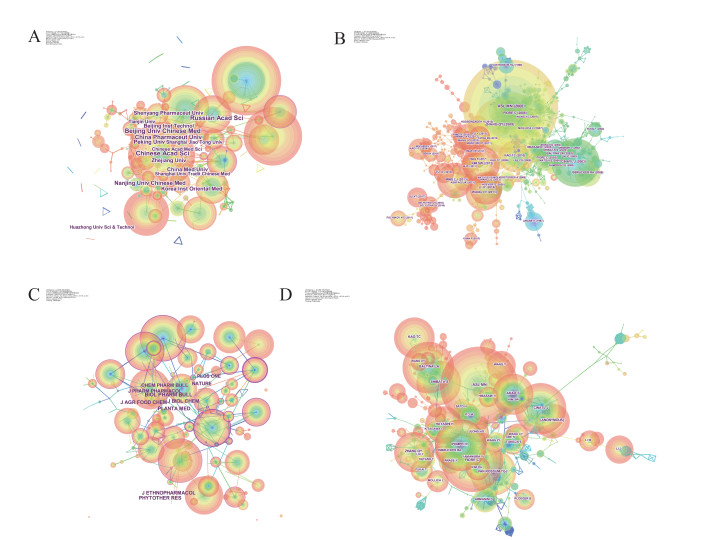
|
| 注: A.发文机构: 节点直径代表了发文数量, 节点之间的连线代表了机构之间的合作情况; B.共被引文献: 节点直径代表了被引用次数, 节点之间的连线代表了文章的合作情况; C.共被引作者: 节点直径代表了作者的被引情况, 节点间连线代表了作者间的合作; D.共被引期刊: 节点直径代表了期刊被引用的情况, 节点间连线代表了期刊互相引用的情况。 图 5 发文机构和被引文献情况 Fig. 5 Publishing institutions and cited articles |
对共被引文献进行分析,得到包含961个节点和2 433条连线的图谱,其中被引频次最高的文献的DOI号分别为Doi 10.1002/Ptr.2362(141次)、Doi 10.1016/J.Chroma.2008.07.072(81次)、Doi 10.1016/S0140-6736(03)13615-X(72次)、Doi 10.1002/Ptr.2295(64次)、Doi 10.1016/J.Nbd.2011.12.056(56次)、Doi 10.1021/Jf2013265(52次)、Doi 10.1155/2014/872139(49次)、Doi 10.1021/Jf101841r(47次)、Doi 10.2174/0929867033368538(40次)、Doi 10.1016/J.YRTPH.2006.06.002(40次)。对共被引作者进行计量分析得到包含708个节点和2 348条连线的图谱,被引频次排在前10的作者分别是Asl M N(239次)、Fiore C(190次)、Pompei R(164次)、Baltina L A(163次)、Cinatl J(161次)、Van Rossum T G J(145次)、Shibata S(139次)、Akao T(132次)、Kao T C(126次)、Zhang Q Y(126次)。对共被引期刊进行计量分析得到包含188个节点和805条连线的图谱,被引次数排在前10的期刊分别是Biological Pharmaceutical Bulletin(672次)、Journal of Ethnopharmacology(637次)、Journal of Agricultural and Food Chemistry(593次)、Planta Medica(581次)、Phytotherapy Research(569次)、Journal of Biological Chemistry(545次)、Nature(490次)、Journal of Pharmacy And Pharmacology(456次)、Chemical & Pharmaceutical Bulletin(451次)、Plos One(436次)。见图 5。
3 讨论在2000—2020年发表的关于甘草酸的2 418篇文章共被引用了48 068次,分析表明,近20年来全球对于甘草酸的研究一直不间断的进行着,发文量呈总体上升趋势。在关键词共现图谱中共有427个关键词被计量分析,相比于Mice(96次),Rat(142次)在近20年中出现的频率更高。Cell在2 418篇文章的关键词中共出现了182次,尤其在2010年后Cell的出现频率剧烈上升,尽可能的以细胞实验代替动物实验以减少实验动物的牺牲逐渐成为学术界的共同追求,出现216次的in Vitro也佐证了这一变化。值得注意的是,自2020年新型冠状病毒肺炎(COVID-19)疫情发生以来,疫情引发的对于实验动物管理条例的进一步严格无疑加速了体外实验代替动物体内实验的步伐,如图 2所示。
出现频率最高的10个关键词中Glycyrrhizic acid、Licorice、Acid、Flavonoid和Glycyrrhiza Glabra偏向于植物学和化学领域,Expression、Apoptosis和Inhibition则偏向于药理学和分子生物学领域。此外,结构(Constituent)出现的频率在2014年达到了峰值,机制(Mechanism)出现的频率则螺旋式上涨。Inflammation、Injury、Liver、Oxidative stress、Hepato-cellular carcinoma等高频词则对应了甘草酸被广为认可的抗炎[13-15]、抗氧化应激[16]、保肝[17-18]和抗肝癌[19-20]的能力。COVID-19则在2020年单年出现了11次[12, 21]。
作者和国家分析显示一共有来自38个国家的778位作者在2000—2020年参与了甘草酸相关论文的发表,发文量排前10的研究方向可以概括为植物学、化学、药理学、分子生物学、微生物学、医学和食品学分别对应了天然药物研究中的形态结构、化学成分[5]、生物活性、临床应用[6, 22]和生物相容性[23-24]几部分,其医学价值和生物相容性是被广泛认可的。提供研究资金最多的10家机构则分别来自中国、日本、美国、俄罗斯和印度。
4 结论文章使用Java程序CiteSpace对Web of Science数据库中甘草酸相关的文献进行文献计量学分析,对得出的计量数据进行分析。根据对共现关键词、国家、作者、机构、共被引文献等信息的分析,得出甘草酸抗炎、抗病毒的生物学活性是其最大的研究热点,其对于病毒性肝炎、肝癌及各类肝损伤的治疗作用值得更多的研究。
| [1] |
HU Y, YU Z, CHENG X, et al. A bibliometric analysis and visualization of medical data mining research[J]. Medicine (Baltimore), 2020, 99(22): e20338. DOI:10.1097/MD.0000000000020338 |
| [2] |
GAO Y, SHI S, MA W, et al. Bibliometric analysis of global research on PD-1 and PD-L1 in the field of cancer[J]. International Immunopharmacology, 2019, 72: 374-384. DOI:10.1016/j.intimp.2019.03.045 |
| [3] |
ZHANG T, YIN X, YANG X, et al. Research trends on the relationship between microbiota and gastric cancer: a bibliometric analysis from 2000 to 2019[J]. Journal of Cancer, 2020, 11(16): 4823-4831. DOI:10.7150/jca.44126 |
| [4] |
KULKARNI A V, AZIZ B, SHAMS I, et al. Comparisons of citations in Web of Science, Scopus, and Google Scholar for articles published in general medical journals[J]. The Journal of the American Medical Association, 2009, 302(10): 1092-1096. DOI:10.1001/jama.2009.1307 |
| [5] |
BALTINA L A. Chemical modification of glycyrrhizic acid as a route to new bioactive compounds for medicine[J]. Current Medicinal Chemistry, 2003, 10(2): 155-171. DOI:10.2174/0929867033368538 |
| [6] |
ASL M N, HOSSEINZADEH H. Review of pharmacological effects of Glycyrrhiza sp.and its bioactive compounds[J]. Phytotherapy Research, 2008, 22(6): 709-724. DOI:10.1002/ptr.2362 |
| [7] |
COON J T, ERNST E. Complementary and alternative therapies in the treatment of chronic hepatitis C: a systematic review[J]. Journal of Hepatology, 2004, 40(3): 491-500. DOI:10.1016/j.jhep.2003.11.014 |
| [8] |
LI J Y, CAO H Y, LIU P, et al. Glycyrrhizic acid in the treatment of liver diseases: literature review[J]. Biomed Research International, 2014, 2014: 872139. |
| [9] |
LI X, SUN R, LIU R. Natural products in licorice for the therapy of liver diseases: Progress and future opportunities[J]. Pharmacological Research, 2019, 144: 210-226. DOI:10.1016/j.phrs.2019.04.025 |
| [10] |
CINATL J, MORGENSTERN B, BAUER G, et al. Glycyrrhizin, an active component of liquorice roots, and replication of SARS-associated coronavirus[J]. Lancet, 2003, 361(9374): 2045-2046. DOI:10.1016/S0140-6736(03)13615-X |
| [11] |
FIORE C, EISENHUT M, KRAUSSE R, et al. Antiviral effects of glycyrrhiza species[J]. Phytotherapy Research, 2008, 22(2): 141-148. DOI:10.1002/ptr.2295 |
| [12] |
BAILLY C, VERGOTEN G. Glycyrrhizin: an alternative drug for the treatment of COVID-19 infection and the associated respiratory syndrome?[J]. Pharmacology & Therapeutics, 2020, 214: 107618. |
| [13] |
KAO T C, SHYU M H, YEN G C. Glycyrrhizic acid and 18 beta-glycyrrhetinic acid inhibit inflammation via PI3K/Akt/GSK3 beta signaling and glucocorticoid receptor activation[J]. Journal of Agricultural and Food Chemistry, 2010, 58(15): 8623-8629. DOI:10.1021/jf101841r |
| [14] |
WANG C Y, KAO T C, LO W H, et al. Glycyrrhizic acid and 18β-glycyrrhetinic acid modulate lipopolysaccharide-induced inflammatory response by suppression of NF-κB through PI3K p110δ and p110γ inhibitions[J]. Journal of Agricultural and Food Chemistry, 2011, 59(14): 7726-7733. DOI:10.1021/jf2013265 |
| [15] |
KIM S W, JIN Y, SHIN J H, et al. Glycyrrhizic acid affords robust neuroprotection in the postischemic brain via anti-inflammatory effect by inhibiting HMGB1 phosphorylation and secretion[J]. Neurobiology of Disease, 2012, 46(1): 147-156. DOI:10.1016/j.nbd.2011.12.056 |
| [16] |
SATHYAMOORTHY Y, KALIAPPAN K, NAMBI P, et al. Glycyrrhizic acid renders robust neuroprotection in rodent model of vascular dementia by controlling oxidative stress and curtailing cytochrome-c release[J]. Nutritional Neuroscience, 2020, 23(12): 955-970. DOI:10.1080/1028415X.2019.1580935 |
| [17] |
TIAN X, LIU Y, LIU X, et al. Glycyrrhizic acid ammonium salt alleviates Concanavalin a-induced immunological liver injury in mice through the regulation of the balance of immune cells and the inhibition of hepatocyte apoptosis[J]. Biomedicine & Pharmacotherapy, 2019, 120: 109481. |
| [18] |
HUO X, MENG X, ZHANG J, et al. Hepatoprotective effect of different combinations of 18α-and 18β-Glycyrrhizic acid against CCl (4)-induced liver injury in rats[J]. Biomedicine & Pharmacotherapy, 2020, 122: 109354. |
| [19] |
SU X, WU L, HU M, et al. Glycyrrhizic acid: a promising carrier material for anticancer therapy[J]. Biomedicine & Pharmacotherapy, 2017, 95: 670-678. |
| [20] |
TSAI J J, PAN P J, HSU F T, et al. Glycyrrhizic acid modulates apoptosis through extrinsic/intrinsic pathways and inhibits protein Kinase B-and extracellular signal-regulated kinase-mediated metastatic potential in hepatocellular carcinoma in vitro and in vivo[J]. American Journal of Chinese Medicine, 2020, 48(1): 223-244. DOI:10.1142/S0192415X20500123 |
| [21] |
TONG T, HU H, ZHOU J, et al. Glycyrrhizic-acid-based carbon dots with high antiviral activity by multisite inhibition mechanisms[J]. Small, 2020, 16(13): e1906206. DOI:10.1002/smll.201906206 |
| [22] |
KWON Y J, SON D H, CHUNG T H, et al. A review of the pharmacological efficacy and safety of licorice root from corroborative clinical trial findings[J]. Journal of Medicinal Food, 2020, 23(1): 12-20. DOI:10.1089/jmf.2019.4459 |
| [23] |
WAN Z, SUN Y, MA L, et al. Responsive emulsion gels with tunable properties formed by self-assembled nanofibrils of natural saponin glycyrrhizic acid for oil structuring[J]. Journal of Agricultural and Food Chemistry, 2017, 65(11): 2394-2405. DOI:10.1021/acs.jafc.6b05242 |
| [24] |
QIU C, WANG J, QIN Y, et al. Characterization and mechanisms of novel emulsions and nanoemulsion gels stabilized by edible cyclodextrin-based metal-organic frameworks and glycyrrhizic acid[J]. Journal of Agricultural and Food Chemistry, 2019, 67(1): 391-398. DOI:10.1021/acs.jafc.8b03065 |
 2022, Vol. 39
2022, Vol. 39




